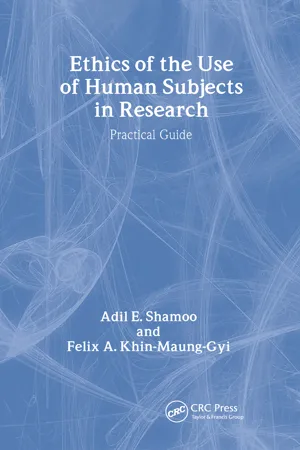Learning Objectives
1. The necessity of using human subjects in research
2. The unprecedented growth of research in the past few decades
3. The Nuremberg Code (1947) as a cornerstone of ethics of the use of human subjects in research
4. The basic ethics theories
5. The most commonly used ethical principles
6. The characteristics of a researcher as a leader
Modern science is based on the continuous acquisition of new knowledge. This now occurs primarily through systematic and organized research undertakings involving multiple investigators and, very frequently, large operations.
The importance of research in advances in national defense, the economy, education, the environment, and health care has been well documented for at least the past 100 years. These advances create new technologies and innovations that keep our economies competitive, and new tools and drugs for patient diagnosis and therapy. For example, the total expenditure in the USA for research and development exceeds $170 billion annually, with federal government funds accounting for less than half of this.
The significant growth of public funding for research in the USA started after World War II (STAE, 1989; Shamoo, 1989). The fruits of research were recognized when resulting knowledge made an important and crucial impact on the outcome of the War. Through grants and contracts, the US Government began to fund university scientists to conduct research in numerous fields such as agriculture, medicine, and science in general. This was a new age for biomedical science research and knowledge, emerging from an unprecedented growth in work largely conducted by university scientists and at the federal campus of the National Institutes of Health (NIH) in Bethesda, Maryland. Since the mid-1980s in particular, industry as well as government have increased dramatically their funding for biological research (Beardsley, 1994).
Research is always carried out in a social and political context, whether initiated by individuals or by collaborations. Thus, societal priorities have a direct impact on what kind of research is funded. Even though researchers strive for objectivity, societal ethical issues are intertwined with the purpose and process of their research. They need to earn and then maintain public trust in order to gain support.
There have been high-profile incidences of research aberrations that have shaped modern discussions of research ethics. Examples include concerns over the use of pesticides, air pollution, radiation, and the human atrocities before and during World War II, including, in the USA, the Tuskegee experiments, and, during the war, experimentation by German and Japanese scientists. The rapid growth of industry, especially the biomedical industry after World War II and more recently the growth of biotechnology, have added greater complexities to the conduct of research, particularly with respect to ethics. In turn, even though the industrial funding for research has been welcomed by most researchers, it has added commercial dimensions to ethical issues for consideration.
Intensified research activity in the USA and internationally have also resulted in significant increases in the use of animals and humans as experimental subjects. The use of people in research is necessitated if new drugs are ever to be used by humans. It is critically important for this to be understood by all the parties involved (i.e. patients, families, researchers, and industrial concerns). If public confidence fails, the use of human subjects in research will decrease and drug development will suffer. If new drugs do not reach the market, desperate patients may use untested and unproven chemicals and drugs to the detriment of their health.
All those involved in clinical research must come to the conclusion that the use of human subjects can and must be conducted in an ethical manner in order to serve the health and well-being of our society.
During World War II, Nazi “researchers” used prisoners – mostly Jews, and mentally retarded and mentally ill people – in experiments that shocked the conscience of the world as they came to light during the Nuremberg trials. The Nuremberg military tribunal issued a strong condemnation of such barbaric behavior towards fellow human beings and issued a code of conduct for research with humans, now known as the Nuremberg Code (ACHRE, 1995). Unfortunately, while paling in comparison with the Nazi scale, human research subject abuse was discovered in the USA prior to and, more disturbingly, after World War II.
The Nuremberg Code identified crucial elements for human subjects’ participation in research. The first and most enduring principle is that “The voluntary consent of the human subject is absolutely essential.” The Code further emphasizes the requirement that the subject must be given sufficient knowledge, be free of duress and coercion, and comprehend the associated risks and benefits.
In 1964, the Helsinki Declaration, adopted by the World Medical Assembly meeting in Helsinki, Finland, followed the Nuremberg Code. It has since been revised five times (for general references, see Beauchamp and Childress, 1994; ACHRE, 1995; Veatch, 1989). The Helsinki Declaration provides more detail on regulating the protection of human research subjects and distinguishes between therapeutic and nontherapeutic research.
